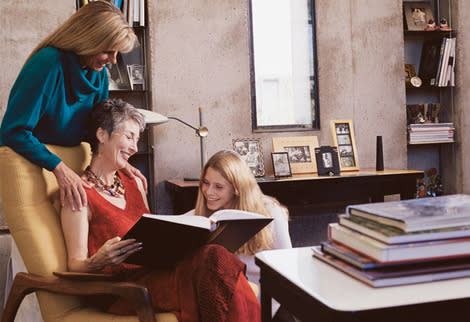5 Things You Never Thought of Doing in Your Hometown

By Corrie Pikul
Most trips home are spent seeing who needs to be seen (grandmothers, nephews, brothers-in-law), avoiding those who need to be avoided (ex-boyfriends, the mean girl from seventh grade, brothers-in-law) and doing our best to stay out of fights (with all of the above). Experts say we can get a lot more out of our trip. Here are seven ways to make the most of your visit.
RELATED: Confrontation for Sissies
1. Cue up videos of your younger, less self-conscious, more exuberant self.
Dig out the recordings of you doing those things you just loved as a kid: twirling the baton, playing the flute, acting in living room theater. Even if these videos contain mortifying moments of flop sweat and botched lines, they'll still make you flush with pleasure, says Tim Wildschut, PhD, an associate professor at the University of Southampton in England, who researches nostalgia. You'll unconsciously emphasize the aspects you loved about this activity-the exhilaration of performing, the release of energy, the pride in your parents' faces-and laugh at or ignore the rest. This activity can help you feel more in touch with the younger version of yourself and boost your confidence in the older version too, says Wildschut.
RELATED: How Self Acceptance Can Crack Open Your Life
2. Get the real story behind that chipped platter your mother refuses to part with.
This not-so-gently-loved plate has become so much a part of the holiday that you've stopped seeing it. This year, get your mother talking about its history, suggests Evan Imber-Black, PhD, director of the Center for Families and Health at the Ackerman Institute for the Family in New York City. Don't just ask who made the platter but also find out how it ended up on your family's table and what it means to your mother. Going home as an adult gives us an opportunity to identify important symbols like these that we might never notice as a child, says Imber-Black, the author of Rituals for Our Times. They can help illustrate the story of your family history and make your relatives seem like complicated, interesting characters from an epic work of fiction by Tolstoy or Franzen.
RELATED: The Trust Test
3. Flip through your high school yearbooks.
This will be even more fun if you do it with a friend, and not just because she can remind you of who that quiet boy who sat next to you in Algebra II was. "We've found repeatedly that sharing happy memories strengthens relationships and brings you closer to others," says Wildschut. It will also put you in a great mood: Research from another British group, separate from Wildschut's, found that looking at favorite old photos made people feel happier than eating expensive chocolate, having a cocktail, listening to music or watching TV.
RELATED: How to Forgive Anyone- and Why Your Health Depends on It
4. Introduce your kids to beloved family members-even if they're no longer around.
You can still help your kids get to know relatives they didn't have a chance to meet by looking at keepsakes, family heirlooms and photos, and sharing personal details and funny stories. One way to make this more interactive is to cut out copies of photos of relatives and play a memory game where the kids collect different faces and tell three facts about each person. This will not only help you and your kids feel connected to the family, but Wildschut says that it can also help you feel a little better about losing those family members you were once close to. "Nostalgia does have a tinge of sadness," he says (remember Chevy Chase as Clark Griswold tearing up while watching family films in Christmas Vacation?). "However, most of the folks in our research report that the joy and the warmth they get from thinking about those people predominates."
RELATED: 9 Great Ways to Connect with Your World
5. Tackle your family tree.
Building a detailed family tree is a massive project-one that can bring your family together and put you in touch with relatives you didn't know you had. It also offers plenty of safe conversation topics ("Where was great-grandpa born, Dad?"). Many families have traced their history back three or even four centuries using Ancestry.com, which has organized over 7 billion records like marriage certificates, census records, military draft cards and ships' passenger lists. For a subscription fee, you get access to a vast database as well as tools that help you organize and share the information. You could also use your Ancestry.com findings to help direct you to historical societies and libraries in your hometown (or other towns) that might provide additional records. Mary Quimby, an Ancestry.com subscriber whose family tree hobby has become nearly a full-time job, has used the Internet, local archives and graveyards to create a family tree that dates back to 1675, and another for her husband that reaches into the early 1500s. She's found that cemeteries often hold the most rewarding clues: While visiting relatives' tombs in a cemetery in Kentucky, she was surprised to find a long-lost great-great-great-grandmother buried nearby. Quimby suggests shaving cream as an easy way to clear the grime off tombstones and get a better look at inscriptions.
KEEP READING: 2 more activities to do in your hometown
More from Oprah.com:
• 11 Ways to Boost Your Mood (or Someone Else's)
• How to Make the Hours You Waste Online More Meaningful
• Should You Really Tell Him Everything
• Makeup to Help You Sparkle
• Subscribe to O, The Oprah Magazine and save up to 78%
Like O, The Oprah Magazine on Facebook
